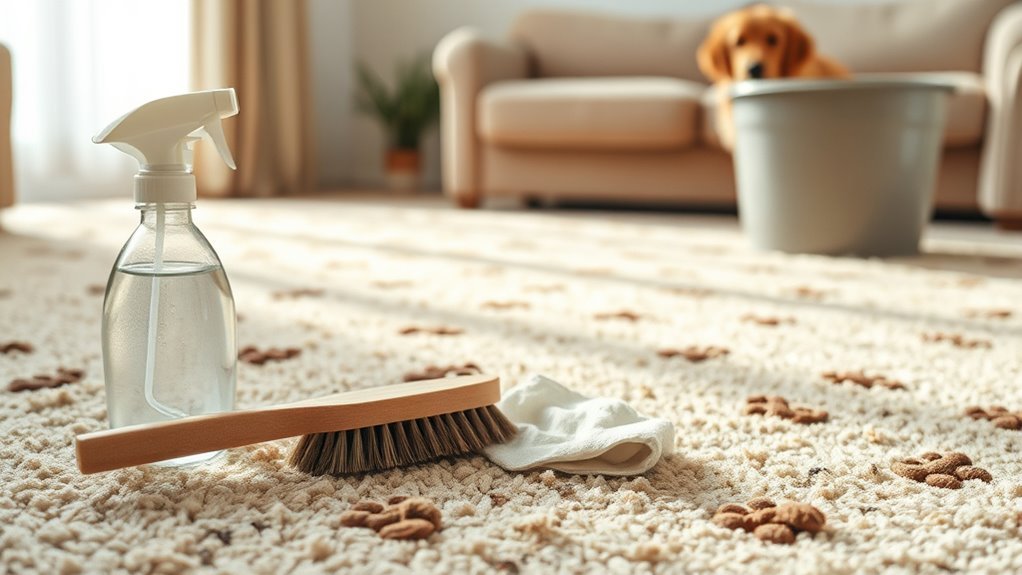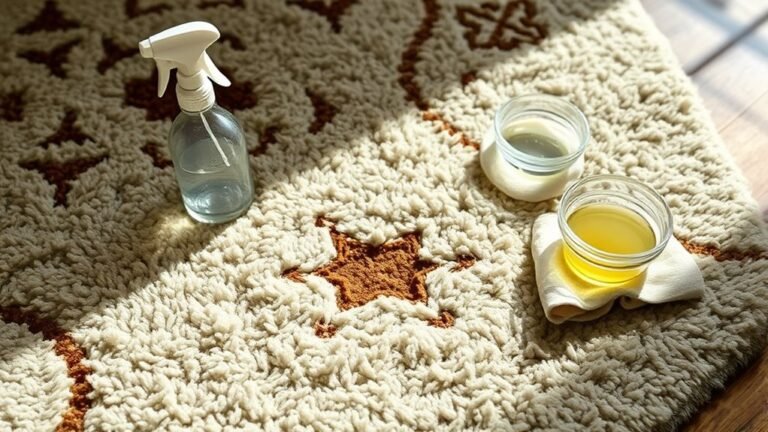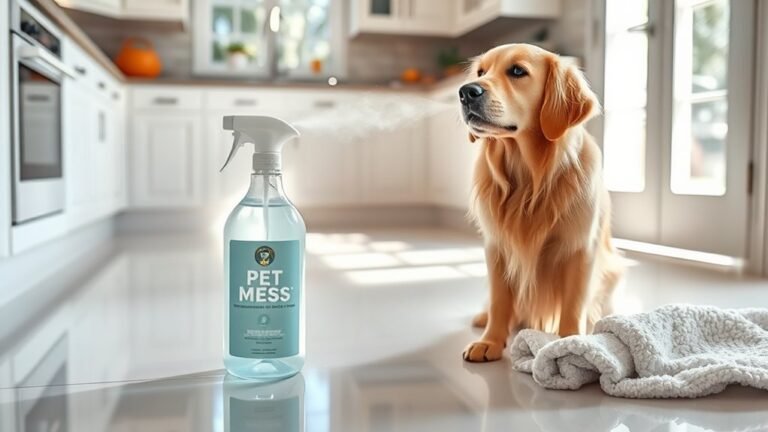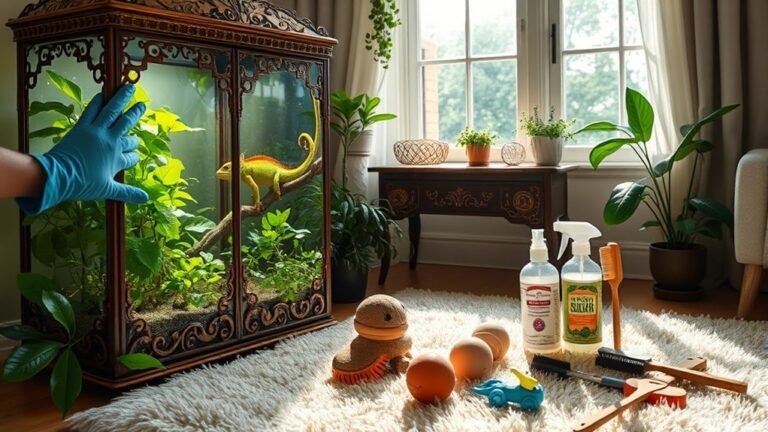How to Clean Pet Mess
When cleaning pet messes, start by identifying the type—mud, urine, hair, or vomit—for the right approach. Use pet-safe cleaners, microfiber cloths, and enzyme treatments to tackle stains and odors efficiently. Blot spills quickly without rubbing, and vacuum regularly to reduce fur buildup. For odors, natural solutions like baking soda and vinegar work wonders. Protect furniture with washable covers and stay on top of cleaning to keep your home fresh. There’s plenty more to help you master pet mess cleanup.
Identifying Different Types of Pet Messes

Before you can effectively clean up after your pet, you need to know what kind of mess you’re dealing with. Different messes require different approaches, so identifying sources is key to maintaining your space without feeling tied down. Whether it’s muddy paw prints, shed fur, or an unexpected accident, recognizing the type of mess helps you tackle it quickly and efficiently. You’ll want to spot if it’s a stain, odor, or debris problem, so you can apply the right technique. By understanding the nature of these messes, you’re free to act confidently and keep your environment fresh without stress. Knowing exactly what you’re up against simplifies cleanup and lets you enjoy your pet’s company without hassle.
Essential Cleaning Supplies for Pet Owners
Once you’ve pinpointed the type of mess your pet has left behind, having the right cleaning supplies on hand makes all the difference. Start by stocking up on pet safe cleaners that effectively break down stains and odors without harsh chemicals. These keep your home fresh and protect your furry friend’s health. Essential tools include absorbent microfiber cloths for quick spills, a sturdy scrub brush for tougher spots, and a handheld vacuum to tackle loose fur and debris. Don’t forget disposable gloves to keep your hands clean and a spray bottle for easy application of cleaning solutions. With these essentials, you’ll be ready to tackle any mess swiftly, giving you more freedom to enjoy the moments with your pet instead of stressing over cleanup.
Removing Mud and Dirt From Carpets and Floors

When mud and dirt get tracked inside, you’ll want to act fast to prevent stains. Using the right cleaning solutions makes all the difference in lifting grime from carpets and floors. Plus, taking quick steps helps stop lingering odors before they set in.
Immediate Mud Removal
Although mud can quickly stain carpets and floors, acting fast can prevent permanent damage. When you notice mud tracking indoors, don’t wait. Start by removing excess mud gently with a dull knife or spoon to avoid pushing it deeper into fibers. For carpets, blot the area with a clean cloth dampened in cool water—never rub, as that spreads the mess. On hard floors, sweep or vacuum loose dirt before wiping with a damp mop or cloth. To minimize mud tracking, establish a quick outdoor cleanup routine for your pet, like wiping paws with a towel before coming inside. Taking these immediate steps keeps your space clean and gives you the freedom to enjoy your home without stubborn stains holding you back.
Effective Cleaning Solutions
If you want to tackle mud and dirt effectively, choosing the right cleaning solution is key. You’ll want to use natural cleaners to protect your space and enzymatic solutions to break down organic stains without harsh chemicals. Here’s a quick guide to help you pick the best option:
| Cleaning Solution | Best For |
|---|---|
| White Vinegar | Natural disinfectant |
| Baking Soda | Odor neutralizer |
| Enzymatic Cleaner | Organic stain removal |
| Mild Dish Soap | General dirt removal |
| Hydrogen Peroxide | Tough stain lift |
These options give you freedom from stubborn messes while keeping your home safe. Stick to these, and you’ll enjoy cleaner carpets and floors without compromising your values.
Preventing Stains and Odors
Choosing the right cleaning solutions is just the first step in managing pet messes. To truly prevent stains and odors, you need a proactive approach. Start by incorporating consistent pet training to reduce accidents indoors. When mud and dirt make their way onto carpets and floors, act quickly—blot the area, don’t rub, to avoid spreading stains. Use odor neutralizers specifically designed for pet messes; these don’t just mask smells but eliminate them at the source, keeping your space fresh and inviting. Regularly clean high-traffic areas where your pet roams to prevent buildup. By combining effective pet training with prompt cleaning and the right odor neutralizers, you’ll maintain a clean, odor-free home that lets you enjoy the freedom of having pets without the mess.
Cleaning Pet Urine Accidents Effectively

When pet urine accidents happen, acting quickly is key to preventing stains and lingering odors. First, blot up as much urine as you can with paper towels or a cloth—don’t rub, or you’ll spread it. Next, use a cleaner with urine enzymes; these break down the proteins causing stains and odors at the source. Avoid harsh chemicals that mask smells temporarily. After applying the enzyme cleaner, let it sit for the recommended time, then blot again. To keep your space fresh, finish with odor neutralizers designed specifically for pet messes—they eliminate the smell without trapping it. By following these steps, you’ll maintain a clean, odor-free home and enjoy the freedom of living with pets without worry.
Tackling Pet Vomit Without Leaving Stains
When your pet vomits, you’ll want to act fast to prevent stains from setting in. Start by removing solids carefully, then blot the area to soak up moisture without rubbing. Next, use the right cleaning solution to break down stains and odors effectively.
Immediate Cleanup Steps
Although pet vomit can be unpleasant, acting quickly will help prevent stains and odors from setting in. First, gather your emergency supplies—paper towels, disposable gloves, a plastic bag, and a mild cleaning spray. Start by carefully removing the solid matter with paper towels, avoiding rubbing to prevent spreading. Next, blot the area gently to soak up excess moisture. Remember, the key is speed and care.
Here are some quick tips: open windows to air out the space and keep your pet away until the area is fully cleaned. Avoid using harsh chemicals that might harm your pet or damage your flooring. With these immediate cleanup steps, you’ll maintain your freedom from lingering messes and keep your home fresh without hassle.
Effective Stain Removal
After you’ve tackled the immediate cleanup, the next step is removing any stains left behind by pet vomit. Different stain types—protein-based or acidic—need specific removal techniques to avoid setting them permanently. For protein stains, use cold water and an enzyme-based cleaner to break down organic matter without spreading the stain. Acidic stains, like those containing bile, respond well to a mixture of water and white vinegar, neutralizing odors and discoloration. Always blot gently rather than rubbing to prevent pushing the stain deeper. If the stain persists, a targeted stain remover designed for pet messes can help. By choosing the right removal techniques for each stain type, you keep your space fresh and stain-free, maintaining your freedom from lingering pet mess reminders.
Dealing With Pet Hair on Upholstery and Fabrics
Since pet hair tends to cling stubbornly to upholstery and fabrics, tackling it can feel like a constant battle. But you don’t have to be trapped by endless fur. For effective pet hair removal, start with a lint roller or a damp rubber glove to lift hair quickly without damaging fabric. Vacuuming regularly with a brush attachment keeps buildup in check and maintains fabric care. If you prefer a natural approach, use a microfiber cloth slightly moistened to attract hair. Don’t forget to check care labels before using any cleaning tool—some fabrics need gentle handling. By staying consistent and using these smart techniques, you’ll reclaim your space from pet hair and enjoy your home freely, without the frustration of stubborn messes holding you back.
Eliminating Odors From Pet Messes Naturally
Removing pet hair from your upholstery is just one part of keeping your home fresh. To truly eliminate odors from pet messes naturally, you can turn to simple, effective ingredients like baking soda and vinegar solutions. Sprinkle baking soda over the affected area and let it sit for at least 15 minutes—this absorbs odors without harsh chemicals. Afterward, vacuum it up thoroughly. For deeper odors, mix equal parts water and white vinegar in a spray bottle and lightly mist the area. Vinegar neutralizes smells without leaving a strong scent behind. Let it air dry completely. These natural methods give you control over your environment without relying on synthetic fragrances or harsh cleaners, helping you maintain a clean, odor-free space where both you and your pets can feel free and comfortable.
Preventing Future Pet Stains and Smells
Although accidents happen, you can take simple steps to prevent future pet stains and smells from becoming a problem. Start by adopting preventive measures like using washable covers on furniture and placing absorbent mats in high-traffic pet areas. Consistent training techniques are key—reward your pet for using designated spots and gently redirect them when they stray. Keeping a routine helps your pet feel secure and reduces accidents. Regularly cleaning areas where your pet spends time removes lingering odors that might invite repeat messes. You can also use enzymatic cleaners to break down organic material, discouraging your pet from returning to the same spot. By combining these strategies, you maintain a fresh home without feeling confined, allowing both you and your pet the freedom to enjoy your space without worry.
Tips for Maintaining a Clean Home With Pets
When you share your home with pets, staying on top of cleanliness takes a bit more effort, but it’s completely manageable with the right habits. Start by choosing pet friendly products designed to tackle messes without harming your furry friends. These make routine cleaning quicker and safer. Set a schedule for vacuuming and wiping surfaces to prevent build-up of fur and dander. Regularly wash pet bedding and toys to keep odors and bacteria at bay. Keep cleaning supplies handy in areas your pets frequent so you can address spills immediately. By sticking to these simple tips, you’ll maintain a fresh, inviting home and enjoy the freedom of living with pets without constant mess stress. It’s all about smart habits, not endless work.
Frequently Asked Questions
How to Clean Pet Messes From Outdoor Furniture?
If you want to keep your outdoor furniture looking fresh, start by removing any solid debris. You can mix gentle cleaning solutions like dish soap and water to scrub away stains and odors. Don’t forget to rinse thoroughly and let everything dry under the sun to prevent mildew. You’ve got the freedom to enjoy your space, so maintaining your furniture with simple, effective cleaning solutions keeps it ready for relaxing moments outdoors.
Are Enzymatic Cleaners Safe for All Pets?
Imagine enzyme safety like a key that fits most locks but not all. Enzymatic cleaners usually break down stains and odors safely for many pets, but if your furry friend has pet allergies or sensitive skin, you should test first. Just like you wouldn’t assume every road leads home, don’t assume all enzymatic cleaners are perfect for every pet. Always check ingredients and consult your vet to keep your freedom to explore mess-free worry.
Can Diet Affect the Frequency of Pet Accidents?
Yes, diet changes can definitely affect how often your pet has accidents. If you switch their food or introduce something new, it might upset their digestive system, leading to more frequent accidents. Paying attention to their diet helps with accident prevention by keeping their tummy happy and regular. You’ve got the freedom to experiment, but just be sure to make any diet changes gradually and watch how your pet responds.
How to Handle Pet Messes on Hardwood Floors?
When you’re dealing with pet messes on hardwood floors, quick action is key. Start by blotting up any liquid with a soft cloth to prevent stains. Use gentle cleaning techniques like a mixture of vinegar and water to clean without damaging the wood. Prevention tips include placing mats near doors and training your pet to use specific areas. This approach helps keep your floors spotless while giving you the freedom to enjoy your space worry-free.
What Are the Best Pet-Safe Disinfectants?
Oh sure, you just want to douse your home in harsh chemicals because that screams “freedom,” right? Instead, why not choose natural disinfectant options with pet safe ingredients? Things like vinegar, baking soda, and essential oils can effectively clean and disinfect without risking your furry friend’s health. You deserve a clean space that doesn’t chain you to toxic fumes—embrace these pet-friendly solutions and enjoy peace of mind and freedom!






